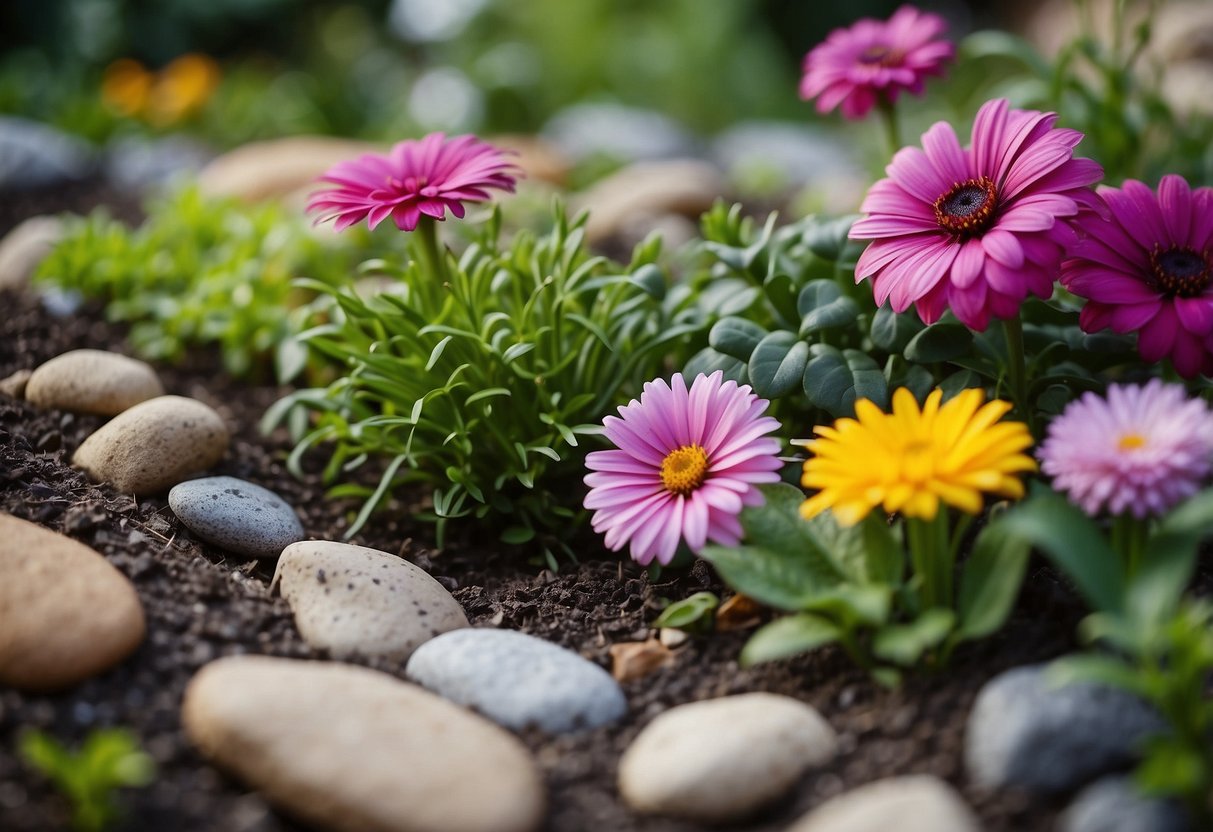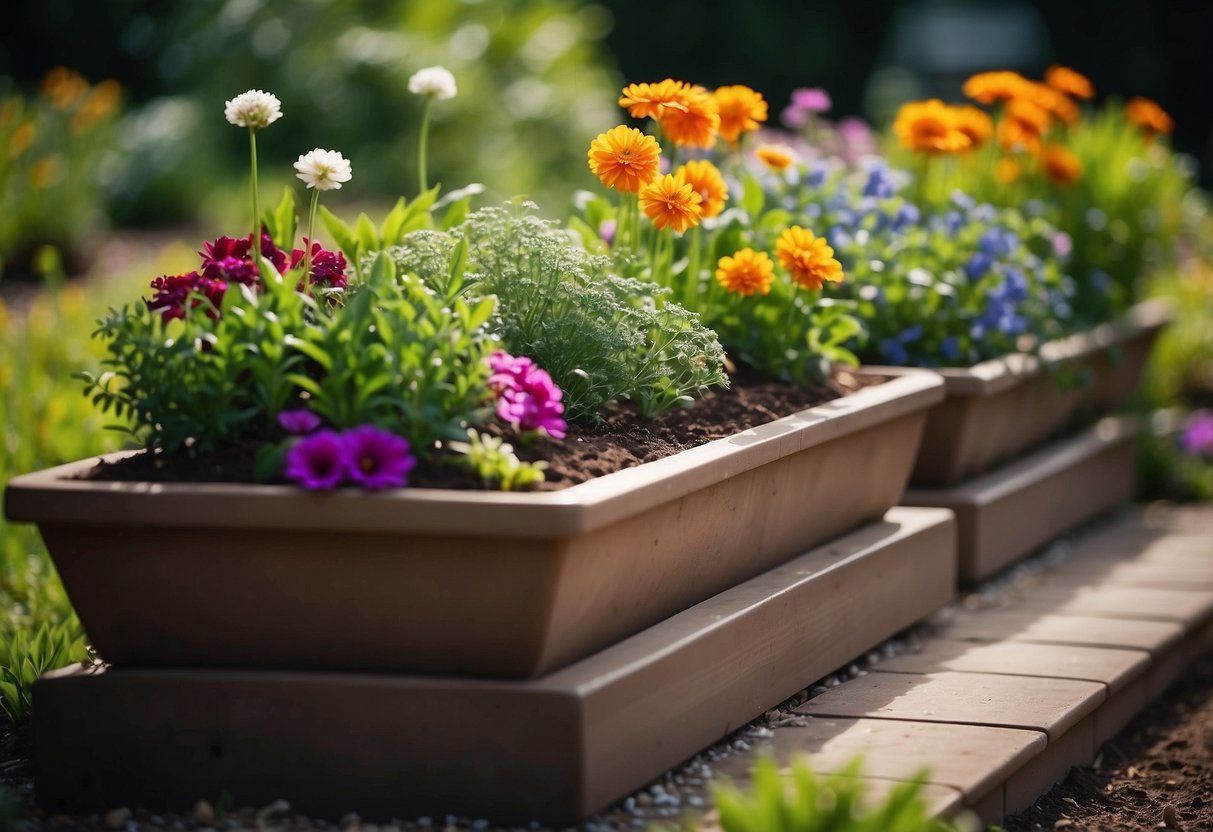Small Garden Bed Ideas: Creative and Compact Solutions
If you’re thinking about starting a small garden, you’re in the right place. Small garden beds can fit into any backyard or even on a small patio, making them perfect for any living situation. A well-planned small garden bed can provide fresh vegetables, herbs, and flowers right at your doorstep.

Small garden beds are not only practical but also relatively easy to set up. With a bit of creativity and effort, you can transform even the smallest spaces into thriving gardens. This article will show you simple and cost-effective ways to create a beautiful small garden bed.
1) Vertical Succulent Wall

A vertical succulent wall can add a unique touch to your garden. This idea uses a shallow wooden box, about 2 inches deep, which is perfect for succulent roots.
Secure a wire mesh to the front of the frame using nails or a staple gun. Then, fill the box with soil and plant your succulents.
For a more creative look, you can transform solid wood shutters into vertical potting boxes. This not only looks great but also saves space. Each pot or box can hold different types of succulents, creating an eye-catching display.
2) Raised Wooden Planter Box

You can create a raised wooden planter box using untreated wood and a few basic tools. This type of garden bed is great for vegetables, herbs, and flowers.
A raised wooden planter box keeps your plants off the ground, protecting them from pests. It’s also easier to control the soil quality, which helps your plants grow healthy and strong.
Using furring strips to build your box is an inexpensive option. You can build a 50.5″ x 50.5″ square bed in about an hour. For more details, visit inexpensive raised garden bed.
3) Hanging Herb Garden

A hanging herb garden is perfect for small spaces and adds a fresh touch to your home.
You can use simple materials like wooden planks, wire, or even old soup cans to create your garden.
Try setting up your herb garden in your kitchen or near a sunny window. For more ideas, check out these hanging herb garden ideas and get inspired!
4) Garden Bed with Trellis

A garden bed with a trellis gives you more space to grow climbing plants like beans and peas. It saves ground space and makes your garden look tidy.
You can build a trellis using materials like cedar fencing or wire mesh. They create a focal point in your backyard.
If you have a small garden bed, consider using a vertical trellis to make the best use of limited space. It’s perfect for plants that have long vines. For specific ideas, you can explore more raised bed trellis ideas for saving space.
5) Recycled Pallet Garden

A recycled pallet garden is a great way to upcycle old wooden pallets. You can use them to create a raised garden bed or even a vertical herb garden. Pallets are sturdy and easy to stack or hang.
To start, make sure your pallets are free from chemicals. Next, secure the pallets by either stacking them or attaching them to a wall. Fill with soil.
The beauty of a pallet garden is its versatility. You can plant vegetables, herbs, or even succulents. It’s a cost-effective and eco-friendly gardening solution. For more ideas, check out these pallet garden projects.
6) Tiered Flower Beds

Tiered flower beds are a great way to add depth and dimension to your small garden. They utilize vertical space and provide multiple layers for planting, making your garden look fuller and more vibrant.
You can build tiered beds using materials like wood, bricks, or even old tires. They are great for growing different types of plants together, such as flowers, herbs, and vegetables.
Consider planting colorful flowers on the top tier and trailing plants on the lower tiers for a cascading effect. This setup not only looks beautiful but also makes it easier to manage your plants. For a unique style, check out these two-tier garden beds.
7) Miniature Rock Garden

A miniature rock garden can transform a small space into a charming feature. Choose small plants like Scotch moss and miniature daffodils for color and texture.
Add creeping groundcovers to soften the look. Consider perennials and ornamental grasses for height. Sturdy bulbs like alliums and wild tulips offer a nice contrast to rocks.
Incorporate antique finds or weather-proof objects for a unique touch. A mini rock garden can look great in a corner or along a pathway, making it perfect for small spaces.
8) Windowsill Herb Boxes

Windowsill herb boxes are a great way to grow fresh herbs in small spaces. You can place them on any windowsill that gets enough sunlight.
Choose herbs like mint, thyme, and oregano. These are easy to grow and manage. You can even use a wooden box or old tea tins.
Make sure your windowsill boxes have good drainage. Water your herbs regularly, but don’t let the soil get too soggy. This setup keeps your herbs healthy and ready to use in your kitchen. Find more ideas for windowsill herb gardens.
9) Self-Watering Container

A self-watering container is a great way to keep your plants hydrated without much effort. These containers have a water reservoir at the bottom. Water moves up through the soil, keeping it moist.
You can make a self-watering planter using materials like buckets, PVC pipes, or even Styrofoam cups. Here are some ideas to get started.
This type of system is perfect if you have a busy schedule or if you often forget to water your plants. Give it a try and see how much easier gardening can be!
10) Compact Vegetable Patch

A compact vegetable patch is a great way to maximize your small garden space.
Raised beds are ideal for this purpose. They help organize plants neatly and make weeding and harvesting easier. You can build raised beds with simple materials like cedar fence pickets.
Using vertical space can also be a game-changer. Trellises and hanging planters let you grow more veggies in less ground space. This method is perfect for vining plants like tomatoes and cucumbers.
With thoughtful planning, even the tiniest patch can provide a bountiful harvest.
Choosing the Right Plants

Picking the right plants is crucial for making the most out of your small garden bed. Consider plants that are well-suited for limited space and those that provide beauty in different seasons.
Best Plants for Small Gardens
When space is limited, it’s important to choose plants that are compact and versatile. For example, Alpine plants like saxifrage and creeping thyme thrive in rocky, well-drained soils and require minimal maintenance. These make a charming, low-maintenance addition to any garden.
Compact varieties of larger plants can also be a good choice. Acer palmatum ‘Little Princess’ grows only up to 5ft and has beautiful seasonal foliage, making it perfect for small gardens. Similarly, the Acer palmatum dissectum ‘Garnet’ reaches up to 6.5ft and offers stunning red leaves.
For a practical and attractive option, consider herbs like basil. Not only do they add greenery and fragrance, but they are also useful in cooking.
Seasonal Planting Tips
Understanding your region’s climate and planting seasons can maximize your small garden’s yield and beauty year-round. Spring is ideal for planting bulbs and early-blooming flowers like tulips, which add bright colors after the winter months.
Summer is great for planting heat-tolerant plants like marigolds and zinnias. These flowers can endure higher temperatures and bring vibrant hues to your garden.
When fall arrives, think about planting mums and ornamental kale, which thrive in cooler temperatures. These plants can provide vibrant colors well into the late season.
During winter, you can plant evergreen shrubs like boxwoods. These provide structure and greenery when most other plants are dormant.
Planning for each season ensures that your garden bed remains beautiful and productive throughout the year.
Designing Your Small Garden Bed

Creating a small garden bed involves strategic planning, especially when it comes to layout and maximizing vertical space. Thoughtful design can help make the most of every inch.
Layout Ideas
Careful planning of your small garden bed layout can help you utilize the space efficiently. Consider circular beds if you have a central spot available. This layout makes it easy to reach plants from all sides and can be surrounded with winding paths and smaller side beds. Raised beds can also create a neat appearance and help with drainage.
Tiered beds offer another creative option. By stacking beds at different heights, you can grow plants that need more sunlight on the top tier and shade-loving plants on the lower tiers.
Using Vertical Space
Maximizing vertical space is essential for a small garden. One way to do this is by using trellises. These structures allow climbing plants like tomatoes, beans, or cucumbers to grow upwards instead of spreading out on the ground.
Another option is to install hanging planters. These can be used for herbs, flowers, or small vegetables and can be hung from fences, walls, or specially designed stands.
Wall-mounted planters or stackable pots are also great for optimizing vertical space. These ideas not only save room but also add an interesting visual element to your garden.
Maintaining a Healthy Garden

Keeping your garden bed thriving involves consistent watering and managing pests effectively. These steps will help ensure your plants grow strong and produce well.
Watering Techniques
Watering your garden properly is crucial. Aim to water early in the morning to reduce evaporation. This allows the soil to absorb moisture efficiently, giving plants the best start to their day.
Use soaker hoses or drip irrigation systems to target the roots directly. These methods are efficient and ensure that the water goes where it’s needed most. If you prefer hand-watering, direct the flow to the base of the plants.
It’s important to check the soil moisture regularly. Stick your finger about an inch into the soil. If it feels dry, it’s time to water. Make sure not to overwater as this can lead to root rot. On hot days, plants might need extra water, so keep an eye on them.
Pest Control
Pests can quickly damage your garden if not addressed. Start by inspecting your plants regularly for signs of trouble. Look for discolored leaves, holes, or any visible insects.
Introducing beneficial insects like ladybugs or lacewings can help keep harmful pests in check. These helpful bugs eat aphids and other harmful critters.
Another method is using natural pest repellents. Neem oil or a mixture of water and dish soap can be sprayed on plants to deter pests. Ensure to spray the underside of leaves where pests often hide.
For larger pests, such as rabbits or deer, consider installing fencing around your garden bed. This physical barrier can prevent them from munching on your plants. With vigilance and the right strategies, you can keep your garden healthy and pest-free.







